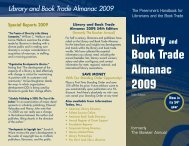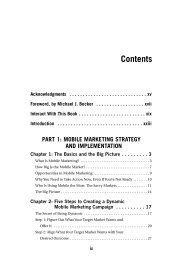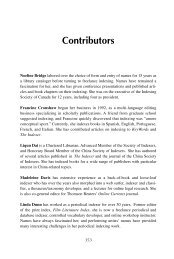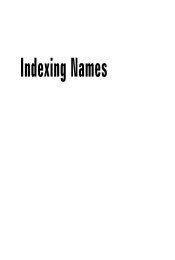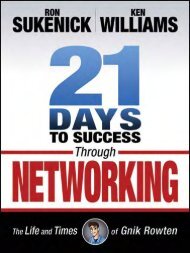Sample Chapter - Books
Sample Chapter - Books
Sample Chapter - Books
- No tags were found...
You also want an ePaper? Increase the reach of your titles
YUMPU automatically turns print PDFs into web optimized ePapers that Google loves.
Seven-Problem Approach to Indexing Names 7subject of <strong>Chapter</strong> 3 by Heather Hedden and is also dealt with extensively in<strong>Chapter</strong> 14 by Martin White. Outside this book, HURIDOCS supplies usages formodern names in different countries, as does IFLA’s Names of Persons. In herchapter, Hedden also discusses the indexing of modern names well known in theWest, where some element of the name has become the one most commonlyreferred to, as with Saddam Hussein (Hussein), Osama bin Laden (bin Laden), andGamal Abdel Nasser (Nasser), advising entry in Western style, beginning with thatknown element.LENGTH OR BREVITY OF A NAME:HOW MUCH TO INCLUDE/EXCLUDEIndexers are often presented with longer and shorter versions of the same person’sname in different texts/projects and within the same book. In back-of-the-bookindexing, and in general, there often isn’t any need to go beyond what is presentedwithin a particular text. Indexing in more “open” contexts, like ongoing periodicalindexing or in large databases, may call for a longer form to be established as theauthoritative version, to distinguish among people with similar names.Biographical dictionaries and encyclopedias will present names in their fullestforms because their users have to make sure of the identities of requested names.Although library cataloging rules have changed over the decades to focus on theform of name “by which [a person] is commonly known” (such as in the Anglo-American Cataloguing Rules, 2nd edition, or AACR2, for example), the Library ofCongress and other library catalogs sometimes have to add details like additionalgiven names and dates of birth and death to distinguish between persons of thesame name. These authorities are invaluable for providing the elements of a namein indexable order, but the indexer must then decide what to include.Relevant here is the distinction between “open” and “closed” indexing, asexplained by Susan Klement (2002). An index can be either static and fixed, or openendedand changing over time. “Closed” indexes are those that, once completed, willnot be altered (for example, a back-of-the-book index or a retrospective periodicalindex). “Open” indexes are those undergoing updating occasionally or continuouslyover a period of time, often years (like encyclopedia, periodical, and databaseindexes). Both types of indexes are dependent on the information available; but in“closed” indexing, the material to be indexed is almost always briefer, the evidence,as it were, less. “Open” indexes often need to use longer forms of names to distinguishone person from another and in anticipation of future confusion.In <strong>Chapter</strong> 14, White advises: “Not attempting to aim higher than the text willlikely save the indexer some headaches.” Mertes, in <strong>Chapter</strong> 2, exhorts: “Unless theindexer has been specifically asked to create a glossary-index, his job is to showreaders where people may be found in the text, not to explain who they are.” Auriol



